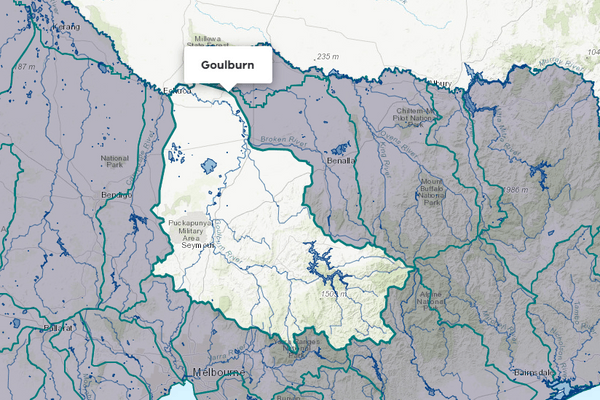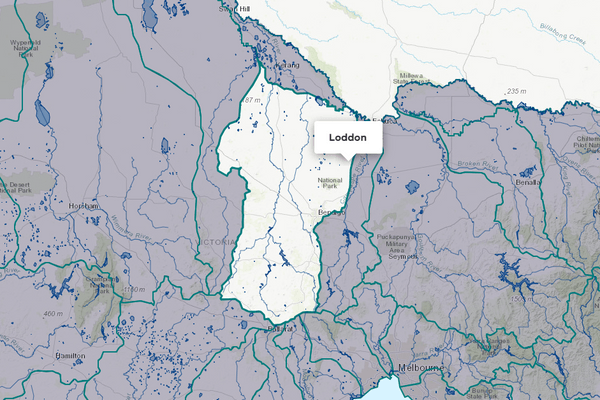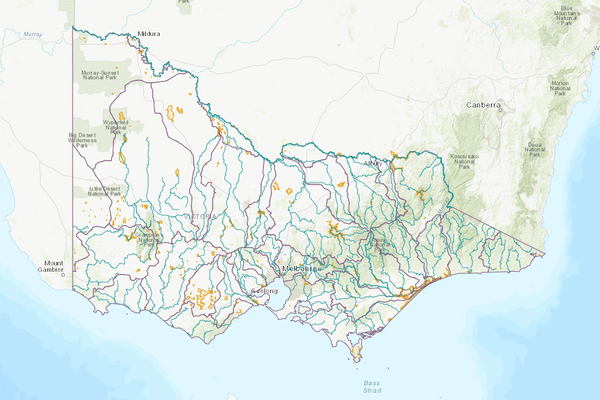About the area
The Campaspe basin is in north-central Victoria. It extends 150 km north from the Great Dividing Range to the Murray River and is 45 km across at its widest point.
The basin experiences hot summers, particularly in the north. Annual rainfall varies from over 900 mm in the southern headwaters to around 400 mm at Echuca.
Most of the basin has been cleared for agriculture; however significant forested areas remain in the Axe Creek catchment and on the southern hills. The areas is dominated by dryland farming which produces cereal crops, beef cattle, lambs and wool, while farming under irrigation is popular in the lower catchment for dairying and fruit and vine growing.
More information on water management and accounting is detailed in Water
2022-23 overview
Available water
Catchment inflow was much higher than the previous year.
Licensed diversion restrictions
A similar level of restrictions on licensed diversions to the previous year.
Seasonal determinations
Campaspe system reached 100% allocation for high and low-reliability water shares - more than the previous year.
Water use
A similar volume of water was diverted for consumptive purposes as the previous year.
When compared to the previous year, in 2022-23:
- more rainfall was received and catchment inflow was much higher (the highest volume in the last 18 years)
- storage levels peaked and declined at higher levels
- there was a similar level of restrictions on licensed diversions from unregulated streams
- high-reliability entitlements reached 100% allocation in the same month
- low-reliability entitlements received an allocation for the first time since 2017-18
- a similar volume of water was diverted from the basin for consumptive uses.
Climate
2022 Flooding
In October 2022, a series of low-pressure systems or surface troughs travelled over south-east Australia, bringing heavy rainfall and storms. The cumulative impact of these on catchments and waterways led to widespread flooding in several basins. Major flooding of the Campaspe River led to inundation in towns including Rochester, Barnadown and Echuca.
Rainfall
In 2022-23, rainfall across the entire Campaspe basin was very much above the long-term average. This was much wetter than the previous year when rainfall was average in most of the basin.
Figure 1 displays the rainfall received in 2022-23 compared to the long-term average (1975-2023).
Figure 1: Rainfall deciles, Campaspe basin
Sourced from the Australian Bureau of Meteorology
River basin water balance
This section describes the known and estimated inflows, outflows and change of storage volumes in the basin.
Of the total inflows, 71% flowed out from the Campaspe River as outflows to the Murray River in 2022-23.
Water balance table
The table below shows the total volumes of water available and supplied from water resources in the Campaspe basin in 2022-23.
Table 1: Water balance, Campaspe basin
Major on-stream storages
Major - greater than 1,000 ML - on-stream storages in the Campaspe basin are included in the water balance.
Storage levels
Storage levels in the Campaspe basin were 97% on 30 June 2023.
Higher than the previous year
On 30 June 2022 storage levels were 56% full.
Table 2: Storage levels, Campaspe basin
Inflows
Catchment inflow
Catchment inflow represents the volume of water flowing into the waterways of a basin. It is calculated as the total outflows and change in storage minus the known inflows.
Above average inflows of 837,579 ML were received (324% of the long-term average of 258,600 ML), much more than the previous year (57% of the long-term average). This was reflective of the very much above average rainfall that fell across the basin in 2022-23.
Above average catchment inflow received
Catchment inflow was 324% of the long-term average annual volume of 258,600 ML.
Much more water received than the previous year
Catchment inflow was much more than the previous year (57% of the long-term average).
Wastewater treatment plants
Water treated at wastewater treatment plants can be used to supplement water available in the basin. Water discharged to waterways from treatment plants is included as an inflow to the water balance.
Information on treatment plants is reported in the water supply local reports for the water corporation responsible for managing the plant.
In this basin, wastewater treatment plants are managed by Coliban and Greater Western
Outflows
Diversions
In 2022-23, 44,139 ML of water was diverted for consumptive uses: town, domestic and stock, irrigation and commercial supply. This was similar to the 41,826 ML diverted in the previous year. Although the total volume diverted was similar, the volume diverted for town, irrigation and commercial supply was lower than the previous year. The 2022-23 consumptive use value was boosted by the 8,087 ML increase in the estimate of small catchment dam use volume.
Small catchment dams
Water harvested, used and lost by small catchment dams (farm dams) is included in the water balance.
Table 3: Small catchment dams, Campaspe basin
Entitlements and compliance
Entitlements provide the basis for how water is shared in the basin.
Entitlements to water in regulated systems in the Campaspe basin provide for the right to carry over unused allocation to the next season. In the Campaspe basin, these entitlement holders can carry over unused water up to 100% of their entitlement volume; any unused water above this amount is written off as an end-of-season forfeiture. Water held above entitlement volume is also subject to a risk of spill: 21,280 ML was written off due to spill events in 2022-23.
Consumptive diversions under bulk entitlements are assessed against the Murray-Darling basin annual cap target for the Campaspe valley. Details of this assessment are published annually in the MDBA’s cap register and annual water take report.
Since 2019-20, the consumptive diversions are also assessed against the annual permitted takes under the Murray-Darling Basin Plan Sustainable Diversion Limit (SDL) compliance reporting which are annually published in the MDBA’s SDL accounts register of take and the Inspector-General of Water Compliance’s SDL compliance statement.
Entitlement volumes
Rights to water in the Campaspe basin are shown in Table 4.
Entitlement volumes represent a maximum volume of water that can be taken in a one-year period. The volume available in a particular year is dependent on the rules for allocating water set out in the entitlement and the seasonal conditions in that year, which can vary. The rules for allocating water under an entitlement differ between entitlements and systems. This affects the ability and likelihood of water being taken in a particular year.
Table 4: Annual entitlement volumes at 30 June, Campaspe basin
Available water and take under entitlements
Total water available under entitlements represents the volume of water that was available to be taken by entitlement holders in 2022-23. The volume includes carryover from the previous year, seasonal allocations and net trade into the basin.
Water available under entitlements
There was 111,031 ML made available under entitlements in 2022-23. This was less than the previous year (122,353 ML).
Water taken under entitlements
There was 44,516 ML taken under entitlements in 2022-23, less than the previous year (67,614 ML).
Seasonal allocations
- High-reliability entitlement allocations opened at 70% and reached 100% in September 2022 (the same month as the previous year). Low-reliability entitlements reached 100% in October 2022. This is the first low-reliability seasonal determination in the Campaspe system since 2017-18.
- For the twelfth year in a row, the 2022-23 Coliban Water rural season opened with an allocation of 100%.
Restrictions on licensed diversions from unregulated rivers
- A total ban was in place for Wanalta Creek for the entirety of 2022-23.
- Diversions from Axe, Cornella, Emu, Jones, McIvor, Mt Ida, Sheep Wash, Smiths, and Sweenies Creeks were banned in July 2022 and lifted between September-November 2022.
- There was a peak of 17 streams with total bans on licensed diversions by February 2023, the same amount as during the previous year.
- There were no restrictions in place for the Coliban River, Meadow Valley Creek, Mia Mia Creek, and Native Gully Creek for the entirety of 2022-23.
Available water and take table
This table shows the volume of available water and the volume taken under entitlements in 2022-23.
More information on available water and take has been detailed in How do we account for surface
In 2022-23, a similar volume of water was available and less was taken under entitlements compared to the previous year.
Table 5: Available water and take under entitlements, Campaspe basin
Compliance
Compliance against water entitlements is reported for this basin in 3 areas:
- entitlement issued: that the volume of entitlements issued in a basin does not exceed formal caps, and has not increased without appropriate approvals
- water taken: that the volume of water taken during the year does not exceed the volume considered to be available for consumptive and/or in-stream use during that year
- bulk entitlement provisions: that holders of entitlements do not breach any provisions that are documented in their bulk entitlement orders.
Total entitlement volume
There was an allowed net increase in the total entitlement volume from the previous year (an overall increase of 17 ML). See note below.
Total volume diverted
The total volume diverted under entitlements (44,516 ML) was within the volume available for the year (111,031 ML).
Individual bulk entitlements
No individual bulk entitlement holder took more than the annual volume made available to them.
Exceptions to compliance
Individual bulk entitlement holders complied with all provisions in their entitlements. However, a compliance difficulty was reported. See note below.
Note to entitlement volume increase:
- Water share volume increased by 37 ML (high-reliability) for the Irrigator Share Distribution. More information on the Irrigator share distribution can be found in Entitlements and compliance.
- Environmental entitlement volumes were amended to recognise best estimates of long-term volume of water recovery resulting from the changes to Victoria's long-term diversion limit equivalent factors in 2019.
- A dimension update was made in the Victorian Water Register to update the location of 17 ML of licensed small catchment dam volumes from the Loddon to Campaspe basin.
Note to compliance difficulties:
- Coliban Water reported that it required an assignment of water allocation from Campaspe bulk entitlement to its Trentham bulk entitlement under Section 46 of the Water Act, as it had exceeded average take of 120 ML per year under its Trentham bulk entitlement. This was approved by a delegate of the Minister for Water.
- Goulburn-Murray Water reported that there were 2 days of minimum flow non-compliance downstream of Lake Eppalock due to higher inflows via a delivery from Coliban Water storages. Minimum passing flows not provided were credited to the passing flow account for later use.
Water for the environment
Environmental watering sites
Environmental watering sites and environmental values in the Campaspe basin that depend on water for the environment include:
- several native fish species, including Murray cod, silver perch, golden perch, Murray-Darling rainbowfish and flat-headed gudgeon
- Platypus, rakali (water rats), turtles and frogs are also present along the length of the river
- riparian vegetation is dominated by large, mature river red gum trees that support wildlife (such as the swift parrot and squirrel glider)
Water from the Campaspe basin also feeds into the Murray basin, helping to maintain internationally significant environmental assets (such as Gunbower Forest and Kerang Wetlands) in that basin.
Environmental water reserve
In 2022-23, water for the environment in the Campaspe basin comprised:
- the Campaspe River Environmental Entitlement 2013, which includes 20,855 ML of high-reliability and 4,394 ML of low-reliability entitlements held by the VEWH
- the Environmental Entitlement (Campaspe River - Living Murray Initiative) 2007, which includes 126 ML of high-reliability and 5,048 ML of low-reliability entitlements held by the VEWH
- 6,594 ML of high-reliability water shares and 395 ML of low-reliability water shares held for the environment
- 30 ML take and use licence held by the Commonwealth Environmental Water Holder (CEWH)
- water set aside for the environment through the operation of passing flow conditions:
- on consumptive bulk entitlements held by Greater Western Water
- on licensed diversions
- all other water in the basin not allocated for consumptive uses: this water also provides social, recreational and cultural benefits.
Environmental water use
In 2022-23, 13,633ML of environmental water was delivered in-stream in the Campaspe basin. This includes 216 ML of passing flows withheld and then delivered under the Bulk Entitlement (Campaspe System - Coliban Water) Conversion Order 1999. There was an additional 440 ML delivered in-stream in the Campaspe River that was diverted from the Goulburn basin.
Management responsibilities
Management of water in the Campaspe basin is undertaken by various parties
| Authority | Management responsibilities |
|---|---|
| Goulburn-Murray Water |
|
| Coliban Water |
|
| Greater Western Water |
|
| North Central Catchment Management Authority |
|
| Water supply system | 2021-22 (ML) | 2022-23 (ML) |
|---|---|---|
| Goornong | 84 | 67 |
| Main integrated system | 184 | 260 |
| Bendigo system | 13,411 | 12,120 |
| Castlemaine system | 2,037 | 1,797 |
| Heathcote system | 370 | 288 |
| Kyneton system | 1,053 | 1,072 |
| Trentham | 140 | 111 |






